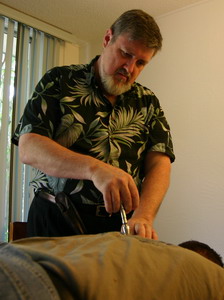 I spend my work days performing adjustments on patients. That is what Chiropractors do. But what is an adjustment? What does it actually do? That's a fair question. Chiropractic is extremely diverse, and your answer will depend on what chiropractor you ask. Chiropractic began more as a health philosophy than a
specific body of studied information. That philosophy was centered on the brain and nervous system with the belief that effective communication between the brain and the body was essential for health. That seems pretty obvious these days, but back when chiropractic started in the 1890s, even the idea of germs as a cause for certain diseases was just catching on.
I spend my work days performing adjustments on patients. That is what Chiropractors do. But what is an adjustment? What does it actually do? That's a fair question. Chiropractic is extremely diverse, and your answer will depend on what chiropractor you ask. Chiropractic began more as a health philosophy than a
specific body of studied information. That philosophy was centered on the brain and nervous system with the belief that effective communication between the brain and the body was essential for health. That seems pretty obvious these days, but back when chiropractic started in the 1890s, even the idea of germs as a cause for certain diseases was just catching on.
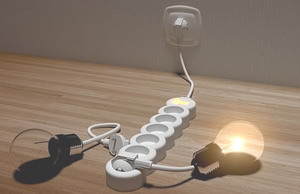 Fundamentally, the broad concept is that if there is interference in nerve function or if nerve signals are getting scrambled in some way, the body will not work right. Back in the simplistic old days, nerve function was seen as a straightforward flow of information from the brain to the muscles and organs. Think of
something as simple as an electrical cord going to a lamp. If the outlet is loose or the switch is worn out, you might see the lamp flicker or not work at all. Back then chiropractors wanted to fix the outlets and switches. The old belief was that these scrambled nerve messages resulted from the joints in the spine getting “out of place” and putting pressure on the nerves directly. Chiropractors manipulate these joints to restore normal mobility and normal nerve flow. This is a nice
easy explanation that is very relatable to patients. It is so easy that many doctors believe it themselves. The truth is so vastly more complex, and everyone hates complex truths. We like simple things. Sorry, the body is anything but simple.
Fundamentally, the broad concept is that if there is interference in nerve function or if nerve signals are getting scrambled in some way, the body will not work right. Back in the simplistic old days, nerve function was seen as a straightforward flow of information from the brain to the muscles and organs. Think of
something as simple as an electrical cord going to a lamp. If the outlet is loose or the switch is worn out, you might see the lamp flicker or not work at all. Back then chiropractors wanted to fix the outlets and switches. The old belief was that these scrambled nerve messages resulted from the joints in the spine getting “out of place” and putting pressure on the nerves directly. Chiropractors manipulate these joints to restore normal mobility and normal nerve flow. This is a nice
easy explanation that is very relatable to patients. It is so easy that many doctors believe it themselves. The truth is so vastly more complex, and everyone hates complex truths. We like simple things. Sorry, the body is anything but simple.
 So now the question is, can I make some of the complex neurology involved in the chiropractic adjustment understandable? Let's give it a shot. Your brain contains a map of everything that is going on in your body at all times. Movement awareness is built into the shape and layout of the nerves in the middle
portion of the outer layer of the brain. Organ functions are regulated in the brain stem. Balance and coordination are handled a little above and behind the brain stem. Neurology is a complicated mess with wiring going every which way. All these areas are constantly taking in messages from every part of the body telling the brain what is going on. From this vast data map, your brain decides what it wants to do and how to coordinate that outcome with all the various parts. Every part talks to
every other part. This is key to understanding the body. This is also why mind-body therapies and Holistic medicine work. This brain inter-connectedness is what the old chiropractors called the Innate Intelligence of the body. Everything talks to everything in the brain. It is really cool, really smart, and really complex!
So now the question is, can I make some of the complex neurology involved in the chiropractic adjustment understandable? Let's give it a shot. Your brain contains a map of everything that is going on in your body at all times. Movement awareness is built into the shape and layout of the nerves in the middle
portion of the outer layer of the brain. Organ functions are regulated in the brain stem. Balance and coordination are handled a little above and behind the brain stem. Neurology is a complicated mess with wiring going every which way. All these areas are constantly taking in messages from every part of the body telling the brain what is going on. From this vast data map, your brain decides what it wants to do and how to coordinate that outcome with all the various parts. Every part talks to
every other part. This is key to understanding the body. This is also why mind-body therapies and Holistic medicine work. This brain inter-connectedness is what the old chiropractors called the Innate Intelligence of the body. Everything talks to everything in the brain. It is really cool, really smart, and really complex!
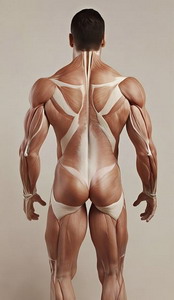 Let's try a simple movement and look at a few of the things going on. Rise from a seated position – just get up from a chair. First, your back stabilizer muscles will have to engage to hold the spine against the changing gravity. Blood flow will have to open up to those muscles and the hip muscles. As the hip
muscles get the message to contract, opposing muscles from the spine to the hip will have to relax and let go at the same rate as the hip muscles are contracting. Your thigh muscles will be doing a similar relaxation and the other contract dance while also having to carefully stabilize the knee to keep your balance. Lower leg and foot muscles have to do the same balance and stabilize actions. All your spine muscles will have to pull the spine into the complex triple-curve which is our standing
posture from the C-curve which is our relaxed sitting posture. Core and secondary stabilizer muscles will have to tighten around the gut area to keep the upper body balanced. The neck will have to bring the head back over the shoulders and orient the eyes for visual balance. (If you have experienced vertigo you know how important that is.) The inner ear balance mechanism measures where you are in space as you are getting up.
Let's try a simple movement and look at a few of the things going on. Rise from a seated position – just get up from a chair. First, your back stabilizer muscles will have to engage to hold the spine against the changing gravity. Blood flow will have to open up to those muscles and the hip muscles. As the hip
muscles get the message to contract, opposing muscles from the spine to the hip will have to relax and let go at the same rate as the hip muscles are contracting. Your thigh muscles will be doing a similar relaxation and the other contract dance while also having to carefully stabilize the knee to keep your balance. Lower leg and foot muscles have to do the same balance and stabilize actions. All your spine muscles will have to pull the spine into the complex triple-curve which is our standing
posture from the C-curve which is our relaxed sitting posture. Core and secondary stabilizer muscles will have to tighten around the gut area to keep the upper body balanced. The neck will have to bring the head back over the shoulders and orient the eyes for visual balance. (If you have experienced vertigo you know how important that is.) The inner ear balance mechanism measures where you are in space as you are getting up.
 This is the simplified version of what goes on in getting up from a chair. So what happens if there is a glitch somewhere in all this complexity? Suppose one or more of those muscles are sore or injured from some activity you did yesterday. The feedback talking about that soreness to the brain
overflows activating some of the seven layers of tiny muscles around the spinal level where the nerves going to those muscles enter the spine. The spinal muscles are like a second brain map of what is going on in the body. Depending upon the nature of the signal coming from the body it will tighten up those muscles and pull the vertebra in different directions. Each vertebra can move potentially in eight different directions and express any combination of those directions. Often the little
spasms get stuck causing inflammation and swelling of the muscles and the joint capsule right where the nerve is. This swelling and inflammation is what messes with the nerve conversation between the brain and the body part. That is what I am spending most of my time checking while you are lying face down on the adjusting table.
This is the simplified version of what goes on in getting up from a chair. So what happens if there is a glitch somewhere in all this complexity? Suppose one or more of those muscles are sore or injured from some activity you did yesterday. The feedback talking about that soreness to the brain
overflows activating some of the seven layers of tiny muscles around the spinal level where the nerves going to those muscles enter the spine. The spinal muscles are like a second brain map of what is going on in the body. Depending upon the nature of the signal coming from the body it will tighten up those muscles and pull the vertebra in different directions. Each vertebra can move potentially in eight different directions and express any combination of those directions. Often the little
spasms get stuck causing inflammation and swelling of the muscles and the joint capsule right where the nerve is. This swelling and inflammation is what messes with the nerve conversation between the brain and the body part. That is what I am spending most of my time checking while you are lying face down on the adjusting table.
 That is just the spine! All sorts of muscles and joints get involved which can alter our natural balance. The body tries to compensate as best it can so you can get around, but it is like trying to drive with one flat tire. Most of the time a hot shower and maybe a cold pack followed by a good night's sleep will
allow the tight muscles to relax and the inflammation and swelling to dissipate. But sometimes it gets stuck, and that is when you call me to get an adjustment. In most situations, one or two adjustments correct the scrambled messages and life is good. But when serious muscle, ligament, and tendon injury take place, as in an auto accident, healing can take quite a while. Simple muscle injuries take 2-3 weeks typically, tendons 1-2 months, and ligaments can take 6 to 8 months if they heal at all.
The differences in time have to do with the amount of blood flow to the injured tissue. Ligaments have almost no blood supply – the same with joint cartilage.
That is just the spine! All sorts of muscles and joints get involved which can alter our natural balance. The body tries to compensate as best it can so you can get around, but it is like trying to drive with one flat tire. Most of the time a hot shower and maybe a cold pack followed by a good night's sleep will
allow the tight muscles to relax and the inflammation and swelling to dissipate. But sometimes it gets stuck, and that is when you call me to get an adjustment. In most situations, one or two adjustments correct the scrambled messages and life is good. But when serious muscle, ligament, and tendon injury take place, as in an auto accident, healing can take quite a while. Simple muscle injuries take 2-3 weeks typically, tendons 1-2 months, and ligaments can take 6 to 8 months if they heal at all.
The differences in time have to do with the amount of blood flow to the injured tissue. Ligaments have almost no blood supply – the same with joint cartilage.
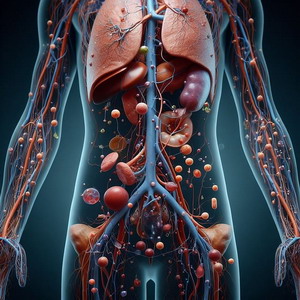 Sometimes this muscle spasm does not involve joints at all. The muscles might be those that control your colon, your stomach, or even blood flow to any area. All your arteries have a muscular layer that regulates blood flow to each organ. That same feedback from the body to the brain is happening all the time from your
gut, liver, heart, and all your innards. The same tension can happen at the spine level. Adjustments can affect the proper function of every tissue that has nerves going to it. If you want to extend that even further, you can look at acupuncture reflex points which can be affected by adjusting the appropriate spinal levels or by stimulating the brain stem. I tend to look for these types of irritation signals on the front of the body and correct them with a stimulus to the brain
stem.
Sometimes this muscle spasm does not involve joints at all. The muscles might be those that control your colon, your stomach, or even blood flow to any area. All your arteries have a muscular layer that regulates blood flow to each organ. That same feedback from the body to the brain is happening all the time from your
gut, liver, heart, and all your innards. The same tension can happen at the spine level. Adjustments can affect the proper function of every tissue that has nerves going to it. If you want to extend that even further, you can look at acupuncture reflex points which can be affected by adjusting the appropriate spinal levels or by stimulating the brain stem. I tend to look for these types of irritation signals on the front of the body and correct them with a stimulus to the brain
stem.
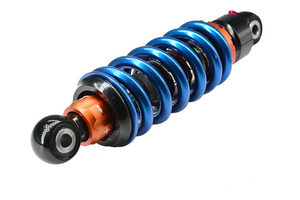 Sometimes I adjust muscles directly. Inside every muscle are little nerve cells called spindle cells that look like tiny springs. How tight or how loose those springs are is what tells the brain how tight or loose the muscle is. I might adjust the tightness on those springs to change that feedback to the brain. The
brain will respond by strengthening or weakening the involved muscle. This is very useful when I am trying to rebalance the body. Muscles have another type of nerve called proprioceptive nerves that tell the brain where the body part is in space as you move the part. Sometimes I will have you stand up and move an arm or leg in different ways to make sure the brain is getting the proper messages. If not then I use the brain stem stimulation to reset that communication.
Sometimes I adjust muscles directly. Inside every muscle are little nerve cells called spindle cells that look like tiny springs. How tight or how loose those springs are is what tells the brain how tight or loose the muscle is. I might adjust the tightness on those springs to change that feedback to the brain. The
brain will respond by strengthening or weakening the involved muscle. This is very useful when I am trying to rebalance the body. Muscles have another type of nerve called proprioceptive nerves that tell the brain where the body part is in space as you move the part. Sometimes I will have you stand up and move an arm or leg in different ways to make sure the brain is getting the proper messages. If not then I use the brain stem stimulation to reset that communication.
 So what is an adjustment? It is the way I rebalance the body by changing feedback loops from the body to the brain and back again. It requires a ton of testing to find what is working and what is not. Fortunately, your body has a system-wide ouch reflex which causes your muscles to lose a little bit of strength for a
few seconds whenever I challenge a compromised muscle, joint, or reflex point. This is the muscle testing I do checking your finger strength, leg length, or spinal muscle tension. Once I find an ouch, I know which way your body wants a correction to neutralize that ouch – most of the time. But sometimes there is damage and inflammation that will have to heal before the adjustment can restore balance.
So what is an adjustment? It is the way I rebalance the body by changing feedback loops from the body to the brain and back again. It requires a ton of testing to find what is working and what is not. Fortunately, your body has a system-wide ouch reflex which causes your muscles to lose a little bit of strength for a
few seconds whenever I challenge a compromised muscle, joint, or reflex point. This is the muscle testing I do checking your finger strength, leg length, or spinal muscle tension. Once I find an ouch, I know which way your body wants a correction to neutralize that ouch – most of the time. But sometimes there is damage and inflammation that will have to heal before the adjustment can restore balance.
 Hopefully, this long-winded explanation gives you some idea of what I am doing when I am adjusting your body. There is one last important piece to this process. While I am an expert at what I do, you are the authority on your body. I can not feel what you feel and I am not in control of what you do after you get off
the adjusting table. I can give advice based on what I find, but only you can choose to follow it or do something else. Only you can evaluate if what I am doing is working based on your feelings and functional experience. I am here as a support person. You run the kingdom of your body.
Hopefully, this long-winded explanation gives you some idea of what I am doing when I am adjusting your body. There is one last important piece to this process. While I am an expert at what I do, you are the authority on your body. I can not feel what you feel and I am not in control of what you do after you get off
the adjusting table. I can give advice based on what I find, but only you can choose to follow it or do something else. Only you can evaluate if what I am doing is working based on your feelings and functional experience. I am here as a support person. You run the kingdom of your body.
Take care,
David
Ellen 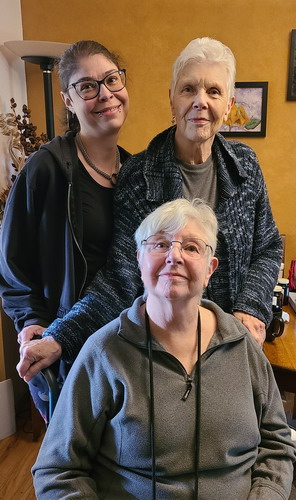
Ellen had a visit by her sister and niece this week when they came by for a shower. That sounds strange, but they live up in Grass Valley and the pump on their well broke. They have been without running water for a couple weeks. It gave the three of them a great chance to chat a bit while I went of to the gym.

